SWEDISH SOUTH ASIAN STUDIES NETWORK
Visits to the heritage places in Kathmandu and Bhaktapur, 1 December 2005
Web page: http://www.worldheritagesite.org/sites/kathmanduvalley.html
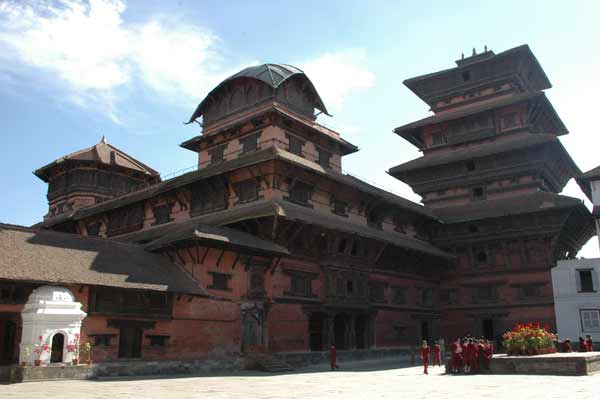 Most
of the day was dedicated to visiting the heritage places in central Kathmandu
(photo to the right) and the town of Bhaktapur, 14 km east of
Kathmandu.
Most
of the day was dedicated to visiting the heritage places in central Kathmandu
(photo to the right) and the town of Bhaktapur, 14 km east of
Kathmandu.
This was due to an invitation from Ram
Govinda Shrestha and Rupa
Dongol, two Nepalese architects who came to Lund University in the
autumn 2005 to participate in a postgraduate International training course
on Conservation and Management of Historic Buildings, organised by the
Dept. of Housing Development and Management
and the Dept. of Architectural Conservation and
Restoration, Lund University. The course is financed by the Swedish
International Development Cooperation Agency, Sida, and was run for the
second year 2005. Professionals working in Latin America and Asia participated
in the first three-weeks period of the training course that was carried
out in Sweden 26 September–14 October 2005, and this will be followed
by a continuation course in either Latin America or Asia (Cambodia) for
two weeks in the spring 2006. For more information on the programme, see
http://www.sasnet.lu.se/hdmlund.html.
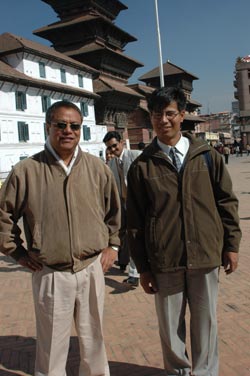 |
| Narendra Raj Shrestha, Head of the Culture, Heritage and Tourism Department, and Ram Govinda Shrestha, Head of the the building conservation department in the Bhaktapur municipality. |
Architects working on restoration projects
Ms Rupa Dongol is working in the Culture,
Heritage and Tourism Department at the Kathmandu Metropolitan City
Office, and she had arranged a programme for us. Since she was going to
marry on the same day, she could however not be with us during the day,
but instead we were invited for her grand wedding reception party at the
Kismis Party Palace in the evening.
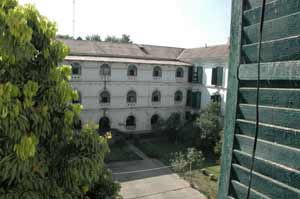 Instead
we were given an appointment to meet Mr. Narendra
Raj Shrestha, Head of the Culture, Heritage and Tourism Department,
located in an old Rana Prime Minister building (one of many) in central
Kathmandu (photo to the left).
Instead
we were given an appointment to meet Mr. Narendra
Raj Shrestha, Head of the Culture, Heritage and Tourism Department,
located in an old Rana Prime Minister building (one of many) in central
Kathmandu (photo to the left).
After receiving us in a typical Nepalese welcoming way, we were given
a silk scarf and a traditional cap, Mr. Shrestha and the department’s
consultant architect Linda Shakya
briefed us about ongoing and planned conservation works carried out in
Kathmandu. The department seems to be doing a very efficient job, given
the small resources and limited staff available. They showed us blueprints
of coming restoration work that includes making new old-style facades
to existing buildings near Durbar Square, buildings that today does not
fit into the environment.
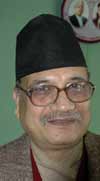 Mr Narendra
Raj Shrestha had got part of his training as an architect in former Soviet
Union in the 1980’s, and had also been to Sweden some years back,
participating in a training course on Urban Land Management, arranged
by the Royal Institute of Technology, KTH, in Stockholm. Linda Shakya
had graduated in 2004 from the College of Civil
Engineering at Tribhuvan University.
Mr Narendra
Raj Shrestha had got part of his training as an architect in former Soviet
Union in the 1980’s, and had also been to Sweden some years back,
participating in a training course on Urban Land Management, arranged
by the Royal Institute of Technology, KTH, in Stockholm. Linda Shakya
had graduated in 2004 from the College of Civil
Engineering at Tribhuvan University.
We also had a chat with Chief Executive of Kathmandu Metropolitan City Office (KMC), Mr Regmi (photo to the left), and discussed the main challenges to the development of the city. He pointed out that the unplanned development is the main cause for problems that concerns the KMC. They include insufficient solid waste management, narrow roads (one solution thought of is constructing alternative roads along the river banks) and lack of parking space in the city centre.
Kathmandu Durbar Square
From KMC we went along with Mr Shrestha and Ms Shakya to Kathmandu Durbar Square, and were heartily received by the staff of the Culture, Heritage and Tourism Department, given flower garlands and presents, and taken to the local office. We were treated as most honoured guests of the city of Kathmandu, and were given a professional guided tour around the old royal palace, the Malla dynasty temples and the temple of the Living goddess.
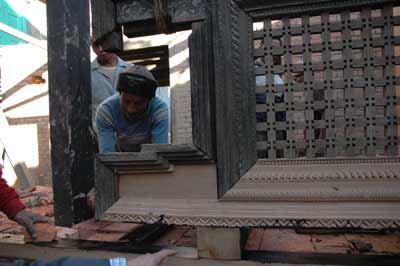 After lunch at a Newari restaurant near Durbar Square in Kathmandu we
then proceeded by car to Bhaktapur, accompanied by Ram
Govinda Shrestha, who heads the building conservation department
in the Bhaktapur municipality.
After lunch at a Newari restaurant near Durbar Square in Kathmandu we
then proceeded by car to Bhaktapur, accompanied by Ram
Govinda Shrestha, who heads the building conservation department
in the Bhaktapur municipality.
The entire central part of Bhaktapur is a World Heritage monument, and
foreigners (except from SAARC countries and China) have to pay 750 rupees
as entrance fee to enter the city. Money that goes directly to finance
conservation works.
Bhaktapur is exceptionally beautiful with its wealth of heritage buildings
from the 12th to the 18th Century AD. Ram Govinda Shrestha, who got his
training as an architect in Saratov in Russia, showed us around and even
let us come inside the Palace of 55 Windows, a building full of fresco
paintings that is currently completely renovated and therefore closed
to the public. Thus we were able to watch the work of the craftsmen working
with sal wood carpentry.
Newari wedding reception party
 We
returned to Kathmandu before dark, in the middle of the rush hours. Therefore
it took more than an hour to reach the city, coming late to the wedding
reception party for which we were invited.
We
returned to Kathmandu before dark, in the middle of the rush hours. Therefore
it took more than an hour to reach the city, coming late to the wedding
reception party for which we were invited.
It was the first evening of the three days of Newari wedding ceremonies,
and only the bride, Rupa Dongol sitting on a dais, was present to receive
presents, not the bridegroom.
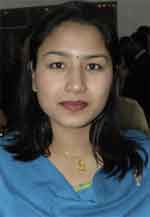 We
were amazed to find the festival hall totally crowded with at least 500
people, mingling around, being served all kinds of Newari food delicacies
and drinks by strolling waiters.
We
were amazed to find the festival hall totally crowded with at least 500
people, mingling around, being served all kinds of Newari food delicacies
and drinks by strolling waiters.
Among the guests we also met Ms. Reshma
Shreshta Duwal (photo to the right), another architect that
participated in the Lund University course on Conservation of Buildings,
but in 2004. Ms. Duwal is also working for the Culture, Heritage and Tourism
Department.
SASNET - Swedish South Asian Studies Network/Lund
University
Address: Scheelevägen 15 D, SE-223 70 Lund, Sweden
Phone: +46 46 222 73 40
Webmaster: Lars Eklund
Last updated
2007-01-11
